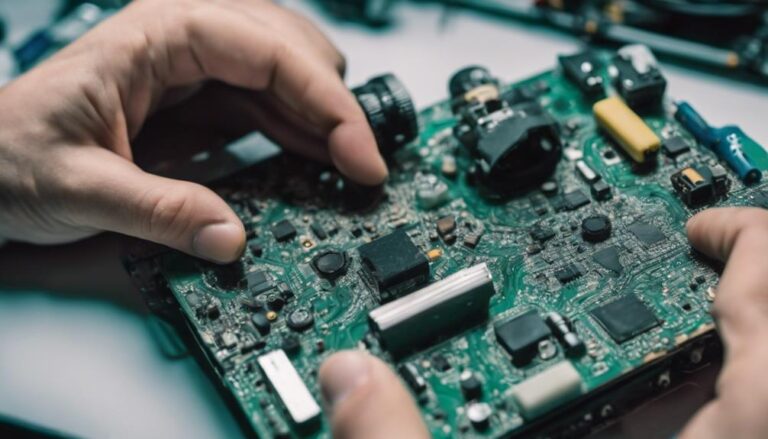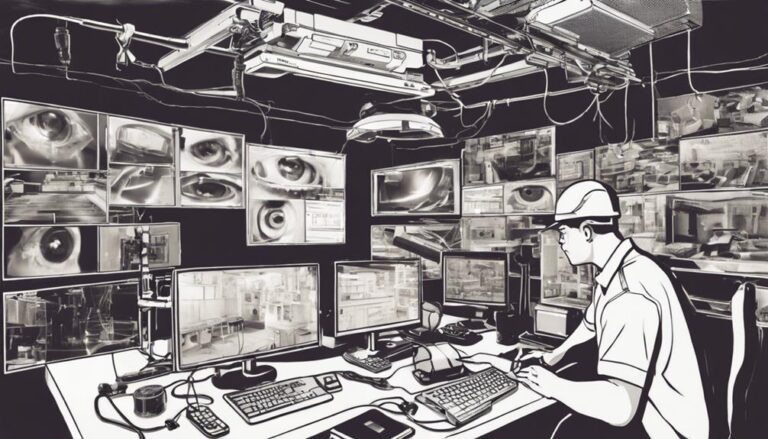Installing your WiFi camera is straightforward. First, unbox it and confirm all components are present. Then, choose the ideal spot for maximum coverage. Mount the camera securely and connect the power adapter, ensuring all cables are well-managed. Once powered up, download the required app and grant necessary permissions. Connect your camera to your WiFi network and configure settings such as motion detection and storage options. These steps will get you started, but there’s more to learn for optimizing your setup.
Unbox Your WiFi Camera
When you first receive your WiFi camera, you’ll want to carefully unbox it to make sure all components are included. Start by removing the outer packaging and any protective coverings. Inside, you should find the camera itself, a power adapter, mounting hardware, and possibly some additional accessories. Don’t forget to look for the warranty card and user manual as well. These are essential documents that you’ll rely on for troubleshooting and making sure your device is covered if anything goes wrong.
As you unbox, take a moment to verify that everything listed in the user manual is present. The manual will usually have a checklist, so use it to confirm you’ve got all the parts. If anything’s missing, consult the warranty card for customer service information. Having all components will ensure a smooth setup process, letting you maintain control and freedom over your home security.
Choose Installation Spot
Choosing the ideal location for your WiFi camera is essential for ensuring maximum coverage and effectiveness. First, think about camera positioning. You want to place your camera where it captures the most important areas without any blind spots. For example, entrances, driveways, and common areas are usually high-priority spots. Make sure the camera is angled to cover the widest area possible, which not only improves security but also reduces the need for multiple cameras.
When it comes to outdoor considerations, weather and lighting are vital. Confirm your camera is weatherproof if you’re installing it outside. Place it under eaves or awnings to protect it from rain and direct sunlight, which can affect its performance. Also, consider the WiFi signal strength; your camera should be within range of your router to function efficiently.
Don’t forget about privacy. Avoid pointing the camera directly into your neighbor’s property to respect their privacy and comply with local laws. You’re aiming for freedom and security without encroaching on others. By thoughtfully selecting the right spot, you’ll maximize your WiFi camera’s potential and keep your space secure.
Mount the Camera
Now that you’ve picked the perfect spot, it’s time to mount your camera. Start by choosing an ideal location that offers a clear view of the area you want to monitor. Next, securely attach the mounting bracket to make certain your camera stays in place.
Choose Ideal Location
Finding the perfect spot for your WiFi camera is essential for ideal coverage and security. Start by considering the camera angle and lighting conditions. You want a vantage point that captures the widest possible view of your area while avoiding blind spots. A corner position often works best, giving you a panoramic perspective. Keep in mind any potential obstructions like trees, walls, or furniture that could block the camera’s view.
Lighting is equally important. Make sure your camera isn’t facing direct sunlight, as it can cause glare and distort the footage. Instead, aim for consistent, even lighting. If you’re installing the camera indoors, position it where natural light is ample but not overwhelming. For outdoor cameras, consider areas with consistent lighting throughout the day and minimal shadows.
Freedom to choose the ideal spot means you can tailor the setup to your unique needs. Perhaps you want to monitor your front door, backyard, or a specific room. Think about the areas that matter most to you and align the camera to focus on those. Balancing angle and lighting will help you achieve a clear, reliable feed that enhances your security.
Secure Mounting Bracket
With your ideal location chosen, it is important to securely attach the mounting bracket to guarantee that your WiFi camera stays in place. You want to make sure your camera’s stability while enjoying the flexibility to adjust it whenever needed. Start by selecting the right bracket material—metal is often the most durable, but high-quality plastic can also do the trick if you’re looking for something lighter.
Next, gather your mounting tools. A drill, screws, and wall anchors are usually necessary, but always check the camera’s manual for specific requirements. Begin by marking the spots where you’ll drill holes, making sure they’re level for a straight mount. Drill the holes and insert wall anchors if you’re mounting on drywall or another less sturdy surface.
Now, attach the bracket using screws. Tighten them securely but avoid over-tightening, as this could damage the bracket material. Once the bracket is firmly in place, you can mount the camera. Make sure it snaps or screws into the bracket securely. Adjust the camera angle to cover the desired area, and you’re all set!
Power Up the Device
Now that your camera is mounted, it’s time to power it up. First, connect the power adapter to the camera and plug it into an outlet. Next, check the LED indicators to confirm that the device is functioning properly before proceeding with the initial setup.
Connect Power Adapter
To power up your WiFi camera, simply plug the power adapter into the camera and connect it to a wall outlet. This step is essential but important for getting your camera up and running. Make sure you take a moment to think about cable management to keep things tidy and avoid any unnecessary tangles.
- Use cable clips: These can help you route the power cable neatly along the wall or furniture.
- Avoid high-traffic areas: Place the cable where it won’t be a tripping hazard or accidentally unplugged.
- Consider a surge protector: This can prevent damage to your device from unexpected power surges.
Free yourself from the clutter and potential hazards by keeping your cables organized. Good cable management not only improves aesthetics but also ensures the longevity of your equipment. As you connect the power adapter, be mindful of the outlet’s location. If it’s in an area prone to power surges, using a surge protector is a wise move. This small step can save you from potential headaches and costly repairs. Once plugged in, your camera will start to receive power, setting the stage for the next steps in your installation process.
Verify LED Indicators
After connecting the power adapter, check the LED indicators to confirm that your WiFi camera is receiving power properly. The LED colors are your camera’s way of communicating with you, so understanding their meanings is vital. Typically, a solid green light indicates that the camera is powered up and functioning correctly. If you see a red light, it might mean there’s an issue with the power connection or the camera itself.
Don’t let this process feel restrictive; it’s a straightforward step that ensures your camera is ready to operate. If your camera has multiple LED indicators, refer to the user manual for a detailed explanation of what each color signifies. For instance, a blinking blue light might mean the camera is attempting to connect to your WiFi network.
You don’t need to be a tech expert to interpret these LED indicators. Just keep an eye on them and make sure they align with the indicator meanings outlined in your manual. If everything checks out, you’re one step closer to a secure, wire-free lifestyle. This simple verification gives you the freedom to set up your camera without any hitches, ensuring smooth sailing ahead.
Initial Device Setup
Powering up your WiFi camera is the next vital step in the installation process. This is where your journey to a more secure and liberated lifestyle begins. First, locate the power cable and adapter that came with your camera. Plug the adapter into a power outlet and connect the cable to the camera. If you’re unsure about the connections, refer to the user manual for detailed instructions.
Once connected, the camera should power up. Look for indicator lights to confirm it’s receiving power. Some cameras may take a few moments to fully boot up, so be patient.
Before proceeding, it’s essential to make sure your camera’s firmware is up-to-date. An outdated firmware can compromise the device’s performance and security. Here’s a quick checklist to follow:
- Check the user manual for instructions on how to update the firmware.
- Visit the manufacturer’s website to download the latest firmware update.
- Follow the update process carefully to avoid any mishaps.
With these steps, your camera will be ready to sync with your WiFi network and provide you with the security and freedom you seek. Don’t rush; taking your time now ensures a smoother experience later.
Download the App
Start by locating and downloading the app specified in your WiFi camera’s user manual. This app is your gateway to a streamlined and intuitive setup process. Once you’ve found it, head over to your device’s app store and hit that download button. Freedom is just a few taps away.
When you first open the app, it might ask for several app permissions. Don’t be alarmed—these are necessary for the app to access your camera’s features. Permissions like access to your location, camera, and microphone make sure you can fully utilize all functionalities, from motion detection to two-way audio. Be mindful of what you’re agreeing to, but remember, these permissions are there to enhance your experience.
Now, take a moment to explore the app interface. It’s designed to be user-friendly, allowing you to navigate through settings and features effortlessly. You’ll find options to adjust camera settings, set alerts, and even customize notifications. The layout is crafted to give you control at your fingertips, making it easy to tailor your camera’s operation to your unique needs. Enjoy the freedom of managing your security seamlessly right from your smartphone.
Connect to WiFi
Once you’re familiar with the app interface, it’s time to connect your camera to your WiFi network. Start by ensuring your router is compatible with the camera’s specifications. Modern WiFi cameras typically support both 2.4 GHz and 5 GHz bands, but it’s wise to double-check.
Next, open the app and navigate to the section where you add a new device. Follow the on-screen instructions to select your camera model. When prompted, enter your WiFi network name and password carefully. This step is essential for maintaining network security and ensuring a stable connection.
Make sure to:
- Verify your router’s compatibility with the camera.
- Check for any firmware updates for both your router and camera.
- Use a strong, unique password for your network to bolster security.
After entering your network details, the app will attempt to connect the camera. This might take a few moments. If it doesn’t connect on the first try, don’t stress. Double-check your network credentials and try again.
Freedom means having a hassle-free setup, and by following these steps, you’re on your way to a smoothly running WiFi camera, all set up for secure and reliable monitoring.
Configure Settings
Setting up your WiFi camera’s settings guarantees you get the most out of its features and functionality. First, delve into the security settings. This is essential for making sure your camera is not only effective but also secure. Change the default username and password to something unique and strong. Don’t use easily guessable info like “admin” or “password123.” This simple step can greatly enhance your device’s security.
Next, check for firmware updates. Manufacturers often release updates to patch vulnerabilities and add new features. Keeping your camera’s firmware up-to-date ensures you’re benefiting from the latest advancements and security improvements. Most camera apps have a section where you can easily check for and install these updates.
Also, configure the motion detection settings to your preference. This feature will alert you anytime there’s movement in the camera’s field of view. Adjust the sensitivity so you’re not bombarded with notifications for every little thing.
Lastly, set up cloud storage or a local storage solution for your recordings. This ensures you have evidence if something goes wrong. By taking these steps, you’re paving the way for a secure and functional WiFi camera setup that gives you peace of mind.
Frequently Asked Questions
How Do I Reset My Wifi Camera to Factory Settings?
To reset your WiFi camera to factory settings, find the reset button and hold it for 10 seconds. Alternative methods include checking the manual or app. Troubleshooting tips: make sure it’s powered, and try different reset durations.
Can Multiple Users Access the Camera Feed Simultaneously?
Imagine a bustling, connected home where everyone can peek into the camera feed. Yes, multiple users can access it simultaneously, but overseeing user permissions guarantees data privacy, letting you enjoy freedom without compromising security.
What Is the Maximum Distance for Wifi Connectivity?
The maximum distance for WiFi connectivity depends on signal strength and interference factors. Ideally, you’ll get up to 150 feet indoors and 300 feet outdoors. However, walls and other devices can impact performance, so plan accordingly.
How Do I Secure My Wifi Camera Against Hacking?
To safeguard your WiFi camera against hacking, maintain robust password management and regularly perform firmware updates. Choose strong, unique passwords and update them periodically. Keep your camera’s firmware current to patch vulnerabilities and enhance security.
What Should I Do if the Camera’s Video Feed Is Blurry?
A clear lens makes for a clear view. Start by lens cleaning to remove any dirt. If that doesn’t help, check for a firmware update. Keeping things up-to-date guarantees you’re seeing the world as it is.



